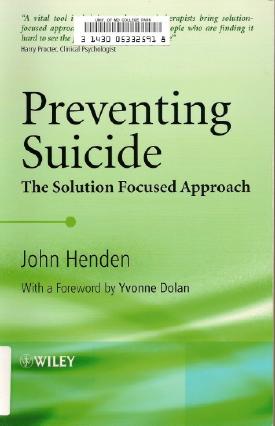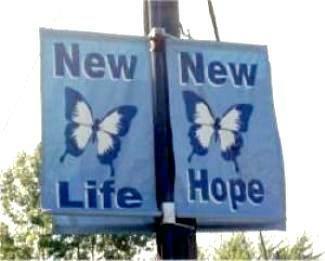
This review was posted in July, 2010.
Review of Preventing Suicide, by John Henden. John Wiley & Sons,
2008, 226 pp., and Hope In Action, by Heather Fiske. Routledge,
2008, 350 pp.
Reviewed by Mary Meehan
These two books can be enormously helpful to everyone who has a
chance to aid those who are tempted by suicide. People in the helping
professions--counselors, therapists, clergy, doctors, nurses, police, and
ambulance crews--will find a wealth of practical ideas in the two books.
They'll also find success stories to give them hope in their difficult work.
Non-professionals who have family members or friends inclined toward
suicide will find the same. So will volunteers on crisis helplines.
Both books were written by therapists with long experience in Solution-Focused
Brief Therapy (SFBT), and both authors have worked with many suicidal people. As
its name implies, SFBT focuses on solutions instead of spending endless
hours on the origins of clients' problems. Through skilled questioning, a
therapist helps clients harness their resources--and their expertise about
their own lives--to build their own solutions. SFBT is called "brief" because it
often takes less time than more traditional approaches. It can help people
who are taking medication for depression or other mental illness. It also can
help people who are just overwhelmed by the death of relatives or friends,
divorce, financial disaster, or other major loss.
In Preventing Suicide, English therapist John Henden says SFBT
assumes "that generally people are competent at finding solutions to most of
what life throws at them." Its practitioners try to avoid "problem thinking"
and "problem talk" by asking clients to notice, before they come for their
first appointment, "what's happening in your life that you want to keep
happening." This sets a hopeful note that the therapist will continue.
Although listening carefully to, and sympathizing with, the real pain the
client suffers, the therapist keeps asking about steps toward a solution. This
can start with: "Up until you got so inactive, what did you do in the day that
interested you?"
Henden recalls an older woman, chronically depressed, who described
at length "how she used to help out at a local playgroup... After a few
minutes, she interrupted herself by saying, 'Listen to me talking! I sound
brighter than I have been for six months!'" Henden learned from her account
"that she had good interpersonal skills, was good with money, was a good
organiser and had general management skills." This gave him much to go on
as they worked together toward solutions.
Especially at the beginning, the emphasis is on very small steps toward
change. Depressed, suicidal people have low energy, so that doing anything
at all seems "a huge effort." But success builds upon success, and moods
improve. Henden says clients develop solution-building skills they can use for
later problems in life, so that most don't need therapy later.
His book includes many special questions that SFBT therapists use to
help their clients think creatively: the "miracle question," the graveside
questions, the "wise old you" question. He presents a long case study and
many shorter ones, with excerpts from therapist-client dialogues. His book is
a splendid introduction to the solution-based approach.
So is Heather Fiske's Hope In Action. Fiske is a Canadian psychologist
and, like Henden and other SFBT practitioners, deeply committed to her
work and always on the lookout for ways to be more effective. She dedicates
her book to her grandmothers and says they lived the book's title. One
chapter includes a brief section on "Grandmother Strategies." Here she
notes: "People in crisis may be in shock; they may have primary needs for
safety, food, warmth or cooling, water, sleep, or medical attention. These
are priorities." She adds that, even when these physical needs are met,
someone in crisis "may be emotionally shocked or numbed and need
reassurance, quiet, simple kindness, and steady, undemanding care and
attention." She remarks that connection with "pets, small children, family
members, friends, stuffed toys or blankets may provide solace and
grounding." Music and "a good pot of tea" may also help.
Fiske, like Henden, offers fascinating case studies and dialogues.
George, a 48-year-old computer consultant, was planning to shoot himself;
his wife discovered this when she found him working on a suicide message.
(Recently he had disappeared often from home and work--and had gambled
to the point of wiping out the family savings and running up a debt. His wife
had discovered this and had threatened divorce.) After a brief, involuntary
commitment to a hospital and pressure from his family doctor and his wife,
George agreed to see Fiske for counseling. He admitted that he lacked
control over his disappearing acts, but said he did exert control on "my kid's
birthday." His son Alex was eight years old. George revealed that both his
son and his wife were very important to him and that he hoped "to conquer
my wild side." He thought he should do more things with his family. With
Fiske's encouragement, he did so and also cut back on gambling. And he
took up several hobbies, which he called "'ways to run away without
leaving.'"
Ten years after her last session with George, Fiske encountered him
in a waiting room. She says he was accompanied by "a big handsome
young man in a university sweatshirt" and that "George smiled and
introduced me to Alex."
Hope In Action offers much more--a wealth of techniques, stories, and
wisdom. And Fiske uses her wry sense of humor to good effect. Thus she
reconstructs Shakespeare's Romeo and Juliet, so that Balthasar intervenes
as Romeo is about to kill himself "and insists that Romeo talk to a distress
line counselor on Balthasar's cell phone." Good counseling reveals that
Romeo has three strong reasons to keep living: to keep Juliet's memory
alive, because Friar Laurance would say that "I must live out my life as a
good man" in order to see Juliet again, and to protect the honor of Romeo's
family.
A great book.

|